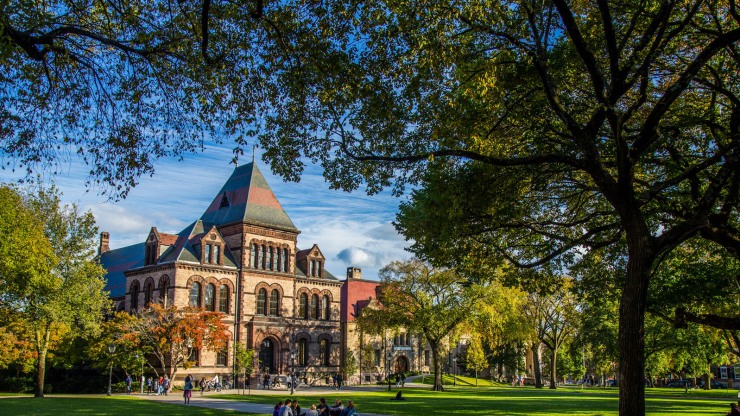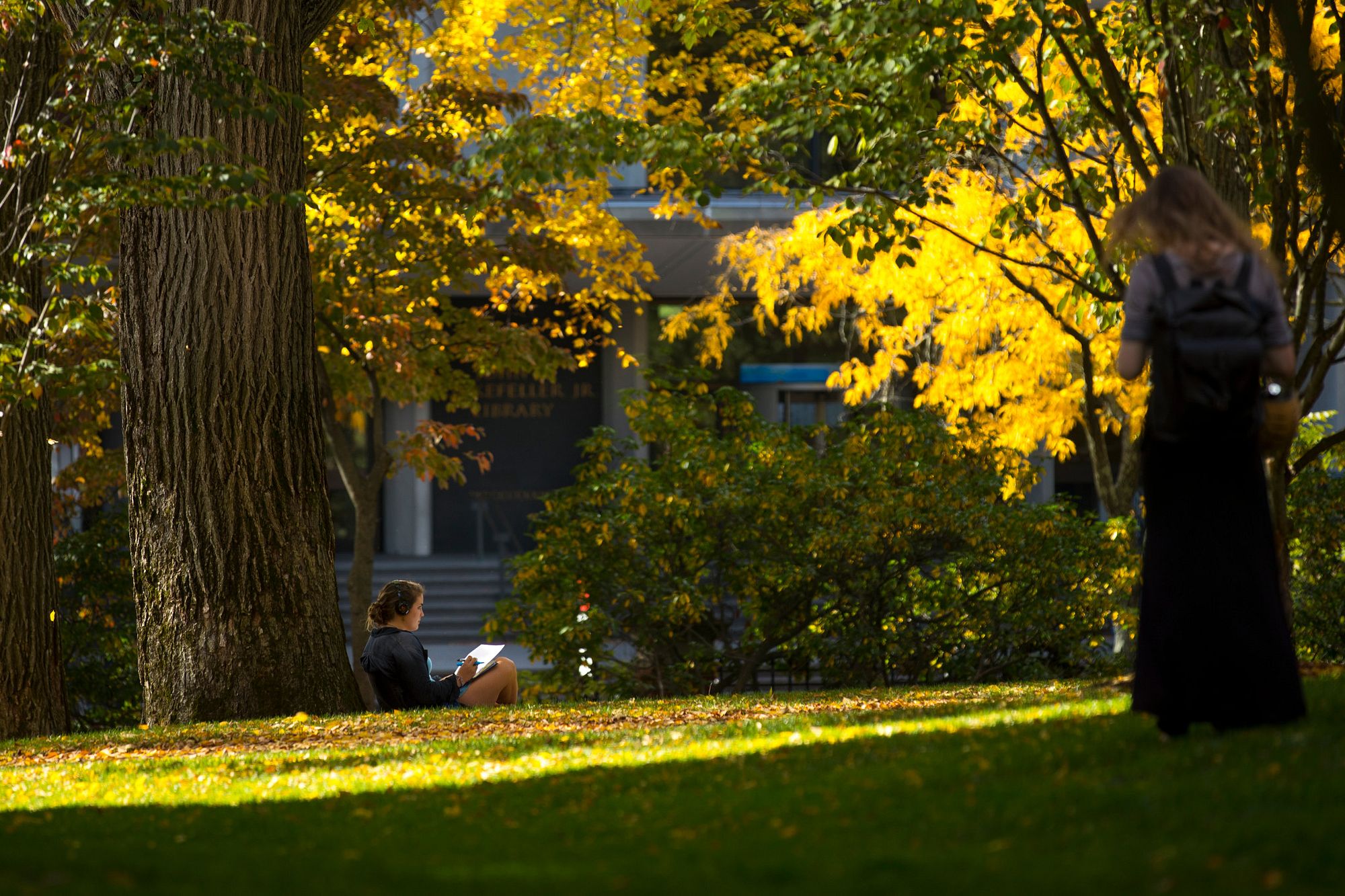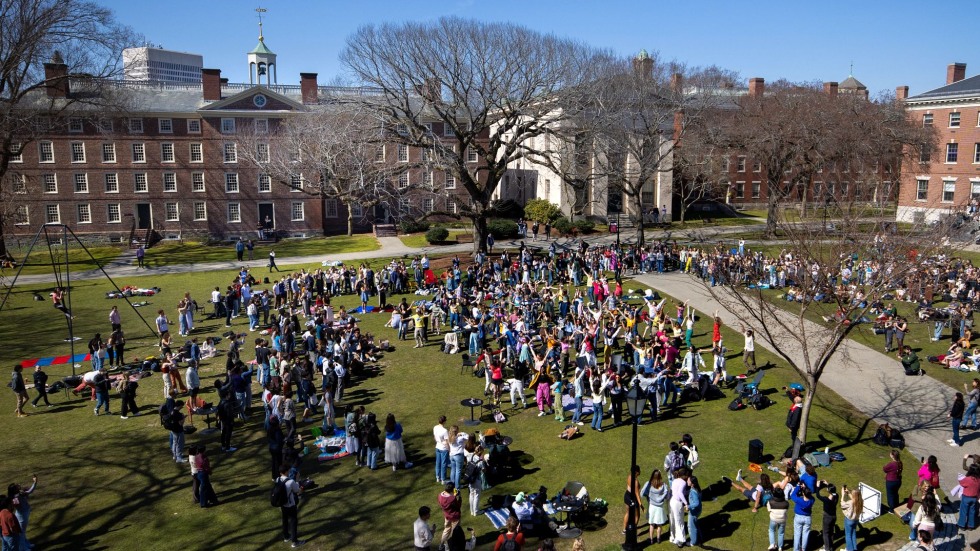5.4.24
Amanda McGregor
amanda_mcgregor@brown.edu
401-863-1008
Brown University’s Facilities Management team branches out across campus to carefully steward and add to nearly 2,500 trees on and around College Hill in the face of threats from pests, disease and climate.

Main Green
Generations of Brunonians have enjoyed Brown University’s lush canopy of trees on campus, which burst with spring buds, offer shade from summer heat, pop with colorful fall foliage and provide a perfect perch for winter snowflakes.
The University’s 155-acre campus is home to approximately 2,500 trees — and nearly 2.7 million square feet of tree canopy — that are carefully stewarded by the Facilities Management team, which also cares for more than 100 trees on city property adjacent to campus. Brown is also home to one of the largest collections of American elms in New England.
Beyond pruning and routine care, tree maintenance continues to grow in complexity in the face of a changing climate and a myriad of pests and pathogens that have been removing entire species of trees from whole regions in a few short decades, threatening some of North America’s most iconic tree species.
“We’re deeply committed to supporting our local healthy urban canopies, which help combat climate change, improve air quality and support local wildlife,” said Paul Armas, assistant vice president of facilities operations at Brown. “And the trees on our campus — particularly some of the larger and older trees in our campus canopy — are treasured by members of the community.”
The American elm is among the species under significant threat, and the historic trees on Brown’s campus have not been immune. After two years of vigorous yet ultimately unsuccessful intervention to save a prized elm near University Hall on the College Green, the tree was removed on Saturday, May 4.
“Tree removal is a last resort,” Armas said. “But sometimes it can be a losing battle in the face of climate change and disease.”
To shepherd trees through unprecedented conditions — including the hottest year on record in 2023, which included record-breaking high temperature days in Rhode Island — campus tree care and resilience continues to demand heightened attention, according to Nicholas Mol, superintendent of grounds at Brown.
“We try to stay at the cutting edge of tree care, and we’re planting hybrid trees that are designed to be more disease resistant and more climate resilient than the older varieties,” said Mol, who noted that Brown’s entire 26-person grounds crew plays a role in tree care on and around campus.
The team uses a pesticide and fungicide application treatment for trees that are impacted by pests and disease, and a pesticide injection program has been conducted on all University elm trees, which are most at risk.
“We are aggressively treating all of our American elms on campus to stave off disease and to slow disease progression for trees that are already infected with Dutch elm disease and other pathogens,” Mol said.

Facilities Management cares for more than 2,500 trees on and around Brown’s campus.
In addition to caring for existing trees, University crews continuously plant new ones with an eye toward cultivating pest-resistant American beech, American elm and Eastern hemlock trees, Mol said. And whenever a tree needs to be removed, another one is planted.
“We planted 15 new trees on campus last fall, and we’re trying to be proactive and stay on the front lines of the effort to preserve and grow the campus tree population,” Armas said.
Brown crews also partner with the City of Providence and local neighbors to care for trees adjacent to campus.
“We prune the city trees, tend to the cobblestones around the base of trees, and we work with our neighbors to plant more trees and care for ones that are damaged,” Armas said. “Tree preservation and tree care are a major focus of our efforts.”
Farewell to a treasured American elm
Despite extensive efforts to save the ailing American elm near the northeast entrance of University Hall — including fertilization, micro-nutrient injections, increased watering, deep aeration to alleviate pressure on the roots and tests for disease — the tree likely succumbed to age and fluctuating temperatures, said Armas, who estimated that the tree is at least 80 years old.

Treasured Elm. Nick Dentamaro
The grounds team first noted signs of stress on the sick American elm when it lost its leaves a few years ago, before foliage season. A tree tissue test didn’t reveal a specific disease, but it became clear this spring when the tree failed to bud again that nearly two years of extensive restoration efforts had no effect.
“It’s disheartening, for sure, even while it’s not entirely unexpected,” Armas said. “And it’s one reason why it’s so essential to focus on adding to our canopy, even as we work to sustain and revitalize our existing trees.”
So tall that it towers over the adjacent four-story University Hall, the dead tree was removed to ensure that it won’t become a safety threat to passersby. Crews cordoned off the area in the days before, to begin preparing the site for removal — a complex and lengthy process for such a large tree that’s in immediate proximity to campus buildings and in a central location on the College Green with heavy foot traffic. Site restoration takes approximately five days, which includes grinding the stump, cleaning up debris and fallen branches, and grading and sodding the ground, Armas said.
In the days following removal of the American elm, crews will be able to count the tree rings and more accurately determine its age. Armas said that several large sections of the tree will be preserved for a memorial project.
“Given the risks a dead tree poses, we proactively proceeded with removal, which is particularly important ahead of Commencement and Reunion Weekend when tens of thousands of people will be walking, gathering and sitting on the College Green,” Armas said. “This is a somber moment as we say goodbye to this majestic tree that has offered its shade and beauty to many generations.”
See the full article here .
Comments are invited and will be appreciated, especially if the reader finds any errors which I can correct.
five-ways-keep-your-child-safe-school-shootings
Please help promote STEM in your local schools.
Brown University is a private Ivy League research university in Providence, Rhode Island. Founded in 1764 as the College in the English Colony of Rhode Island and Providence Plantations, Brown is the seventh-oldest institution of higher education in the United States and one of the nine colonial colleges chartered before the American Revolution.
At its foundation, Brown University was the first college in North America to accept students regardless of their religious affiliation. The university is home to the oldest applied mathematics program in the United States, the oldest engineering program in the Ivy League, and the third-oldest medical program in New England. The university was one of the early doctoral-granting U.S. institutions in the late 19th century, adding masters and doctoral studies in 1887. In 1969, Brown adopted its “Open Curriculum” after a period of student lobbying. The new curriculum eliminated mandatory “general education” distribution requirements, made students “the architects of their own syllabus” and allowed them to take any course for a grade of satisfactory (Pass) or no-credit (Fail) which is unrecorded on external transcripts. In 1971, Brown’s coordinate women’s institution, Pembroke College, was fully merged into the university.
Admission is among the most selective in the United States; the university’s acceptance rate is approximately 5.4%.
The university comprises the College; the Graduate School; Alpert Medical School; the School of Engineering; the School of Public Health and the School of Professional Studies. Brown’s international programs are organized through The Watson Institute for International and Public Affairs at Brown University , and the university is academically affiliated with the UChicago Marine Biological Laboratory in Woods Hole, Massachusetts and The Rhode Island School of Design. In conjunction with the Rhode Island School of Design, Brown offers undergraduate and graduate dual degree programs.
Brown’s main campus is located in the College Hill neighborhood of Providence, Rhode Island. The university is surrounded by a federally listed architectural district with a dense concentration of Colonial-era buildings. Benefit Street, which runs along the western edge of the campus, contains one of the richest concentrations of 17th and 18th century architecture in the United States.
Nobel Prize winners have been affiliated with Brown as alumni, faculty, or researchers, as well as National Humanities Medalists and National Medal of Science laureates. Other notable alumni include Pulitzer Prize winners, a number of billionaires, a U.S. Supreme Court Chief Justice, U.S. Secretaries of State, members of the United States Congress, Rhodes Scholars, MacArthur Genius Fellows, and Olympic medalists.
The foundation and the charter
In 1761, three residents of Newport, Rhode Island, drafted a petition to the colony’s General Assembly:
“That your Petitioners propose to open a literary institution or School for instructing young Gentlemen in the Languages, Mathematics, Geography & History, & such other branches of Knowledge as shall be desired. That for this End… it will be necessary… to erect a public Building or Buildings for the boarding of the youth & the Residence of the Professors.”
The three petitioners were Ezra Stiles, pastor of Newport’s Second Congregational Church and future president of Yale University; William Ellery, Jr., future signer of the United States Declaration of Independence; and Josias Lyndon, future governor of the colony. Stiles and Ellery later served as co-authors of the college’s charter two years later. The editor of Stiles’s papers observes, “This draft of a petition connects itself with other evidence of Dr. Stiles’s project for a Collegiate Institution in Rhode Island, before the charter of what became Brown University.”
The Philadelphia Association of Baptist Churches were also interested in establishing a college in Rhode Island—home of the mother church of their denomination. At the time, the Baptists were unrepresented among the colonial colleges; the Congregationalists had Harvard University and Yale University, the Presbyterians had the College of New Jersey (later Princeton University), and the Episcopalians had The William & Mary College and King’s College (later Columbia University). Isaac Backus, a historian of the New England Baptists and an inaugural trustee of Brown, wrote of the October 1762 resolution taken at Philadelphia:
“The Philadelphia Association obtained such an acquaintance with our affairs, as to bring them to an apprehension that it was practicable and expedient to erect a college in the Colony of Rhode-Island, under the chief direction of the Baptists; … Mr. James Manning, who took his first degree in New-Jersey college in September, 1762, was esteemed a suitable leader in this important work.”
James Manning arrived at Newport in July 1763 and was introduced to Stiles, who agreed to write the charter for the college. Stiles’ first draft was read to the General Assembly in August 1763 and rejected by Baptist members who worried that their denomination would be underrepresented in the College Board of Fellows. A revised charter written by Stiles and Ellery was adopted by the Rhode Island General Assembly on March 3, 1764, in East Greenwich.
In September 1764, the inaugural meeting of the corporation—the college’s governing body—was held in Newport’s Old Colony House. Governor Stephen Hopkins was chosen chancellor, former and future governor Samuel Ward vice chancellor, John Tillinghast treasurer, and Thomas Eyres secretary. The charter stipulated that the board of trustees should be composed of 22 Baptists, five Quakers, five Episcopalians, and four Congregationalists. Of the 12 Fellows, eight should be Baptists—including the college president—”and the rest indifferently of any or all Denominations.”
At the time of its creation, Brown’s charter was a uniquely progressive document. Other colleges had curricular strictures against opposing doctrines, while Brown’s charter asserted, “Sectarian differences of opinions, shall not make any Part of the Public and Classical Instruction.” The document additionally “recognized more broadly and fundamentally than any other [university charter] the principle of denominational cooperation.” The oft-repeated statement that Brown’s charter alone prohibited a religious test for College membership is inaccurate; other college charters were similarly liberal in that particular.
The college was founded as Rhode Island College, at the site of the First Baptist Church in Warren, Rhode Island. James Manning was sworn in as the college’s first president in 1765 and remained in the role until 1791. In 1766, the college authorized Rev. Morgan Edwards to travel to Europe to “solicit Benefactions for this Institution.” During his year-and-a-half stay in the British Isles, the reverend secured funding from benefactors including Thomas Penn and Benjamin Franklin.
In 1770, the college moved from Warren to Providence. To establish a campus, John and Moses Brown purchased a four-acre lot on the crest of College Hill on behalf of the school. The majority of the property fell within the bounds of the original home lot of Chad Brown, an ancestor of the Browns and one of the original proprietors of Providence Plantations. After the college was relocated to the city, work began on constructing its first building.
A building committee, organized by the corporation, developed plans for the college’s first purpose-built edifice, finalizing a design on February 9, 1770. The subsequent structure, referred to as “The College Edifice” and later as University Hall, may have been modeled on Nassau Hall, built 14 years prior at the College of New Jersey. President Manning, an active member of the building process, was educated at Princeton and might have suggested that Brown’s first building resemble that of his alma mater.
The College
Founded in 1764, The College is Brown’s oldest school. About 7,200 undergraduate students are enrolled in the college, and 81 concentrations are offered. Among the most popular concentrations were Computer Science, Economics, Biology, History, Applied Mathematics, International Relations and Political Science. A quarter of Brown undergraduates complete more than one concentration before graduating. If the existing programs do not align with their intended curricular interests, undergraduates may design and pursue independent concentrations.
Approximately 35 percent of undergraduates pursue graduate or professional study immediately, 60 percent within 5 years, and 80 percent within 10 years. Among undergraduate alumni who go on to receive graduate degrees, the most common degrees earned are J.D. (16%), M.D. (14%), M.A. (14%), M.Sc. (14%), and Ph.D. (11%). The most common institutions from which undergraduate alumni earn graduate degrees are Brown University, Columbia University, and Harvard University.
The highest fields of employment for undergraduate alumni ten years after graduation are education and higher education (15%), medicine (9%), business and finance (9%), law (8%), and computing and technology (7%).
Brown and RISD
Since its 1893 relocation to College Hill, Rhode Island School of Design (RISD) has bordered Brown to its west. Since 1900, Brown and RISD students have been able to cross-register at the two institutions, with Brown students permitted to take as many as four courses at RISD to count towards their Brown degree. The two institutions partner to provide various student-life services and the two student bodies compose a synergy in the College Hill cultural scene.
Rankings
Brown University is accredited by the New England Commission of Higher Education. The Wall Street Journal/Times Higher Education has ranked Brown very high in the Best Colleges 2021 edition.
The Forbes Magazine annual ranking of America’s Top Colleges —which ranked 600 research universities, liberal arts colleges and service academies—ranked Brown very high overall and very high among universities.
U.S. News & World Report has ranked Brown very high among national universities. Brown has also ranked very high for undergraduate teaching, very high in Most Innovative Schools and in Best Value Schools.
Washington Monthly ranks Brown very high among national universities in the U.S. based on its contribution to the public good, as measured by social mobility, research, and promoting public service.
U.S. News & World Report has ranked Brown very high globally.
Forbes Magazine has ranked Brown very high on its list of “America’s Most Entrepreneurial Universities.” The Forbes analysis looked at the ratio of “alumni and students who have identified themselves as founders and business owners on LinkedIn” and the total number of alumni and students.
LinkedIn particularized the Forbes rankings, placing Brown very high (between The Massachusetts Institute of Technology and Princeton University) among “Best Undergraduate Universities for Software Developers at Startups.” LinkedIn’s methodology involved a career-path examination of “millions of alumni profiles” in its membership database.
U.S. News has ranked Brown’s Warren Alpert Medical School very high among the most selective in the country, with an acceptance rate of approximately 2.8 percent.
According to data from The Department of Education, the median starting salary of Brown computer science graduates was very high in the United States.
Brown has produced a very high number of Fulbright winners.
Research
Brown is member of The Association of American Universities since 1933 and is classified among “R1: Doctoral Universities – Very High Research Activity”. Brown spends over $250 million on research and was ranked very high in the United States by total R&D expenditure by The National Science Foundation.


